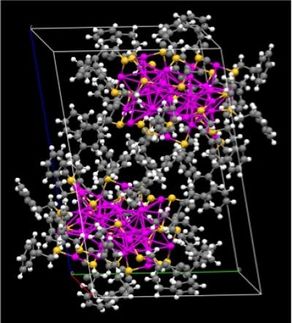Hula-Hoop Nanotechnique
Periodic nanostructures made of gold nanoparticles and long DNA strands with repeated sequences
Multifaceted DNA: in our bodies it carries our genetic information; in the hands of scientists it continues to reveal itself as the material of choice for nanotechnology. DNA is very stable and mechanically strong, and because of the specific base pairing in the double strand predictable structures are accessible. Canadian researchers led by Michael A. Brook and Yingfu Li have now successfully produced specific, periodic three-dimensional nanostructures from long single strands of DNA and gold nanoparticles. The researchers see nanocomputers, nanocircuits, and highly sensitive biosensors as potential areas of application.
The secret to their success is a DNA duplication technique known as "rolling circle amplification" or the "hula-hoop" technique. A ring of single-stranded DNA is used as the model, a special polymerase enzyme "reads" this model and builds the corresponding complementary strand. When this is complete, this type of polymerase, unlike ordinary polymerases, does not stop working. It is able to separate the fresh strand from the original and continues to copy the model again without interruption. This leads to long (theoretically infinitely long) single strands of DNA with a sequence of repeating patterns.
The team attached short DNA fragments to gold nanoparticles with a diameter of 15 nm. Tiny rings of DNA were then hooked on by way of specific base pairs and a hula-hoop-capable form of polymerase was added. That started it off: round and round the loop until long DNA chains hung from the little gold spheres. In order to demonstrate that these aggregates are good scaffolds for 3D structures, the researchers added smaller gold particles (5 nm diameter), each equipped with one short DNA segment. The sequence of these fragments was complementary to one region of the repeated sequence of the long DNA chains, so the fragments docked onto the larger structure. Because the pattern periodically repeats, the long DNA strands were now equipped with many little gold particles at regular intervals-like pearls on a necklace. The result is a periodic nanostructure.
"The construction and microstructure of such three-dimensional nano-entities can easily be controlled. Because DNA base pairing can also be broken up, these structures can be reversibly put together and taken apart again." Brook and Li consider this to be one of the special advantages of their "nanoconstruction kit".
Original publication: Y. Li; "DNA Polymerization on Gold Nanoparticles through Rolling Circle Amplification: Towards Novel Scaffolds for Three-Dimensional Periodic Nanoassemblies"; Angewandte Chemie International Edition 2006, 45, 2409.
Other news from the department science
Most read news
More news from our other portals
See the theme worlds for related content
Topic world Sensor technology
Sensor technology has revolutionized the chemical industry by providing accurate, timely and reliable data across a wide range of processes. From monitoring critical parameters in production lines to early detection of potential malfunctions or hazards, sensors are the silent sentinels that ensure quality, efficiency and safety.

Topic world Sensor technology
Sensor technology has revolutionized the chemical industry by providing accurate, timely and reliable data across a wide range of processes. From monitoring critical parameters in production lines to early detection of potential malfunctions or hazards, sensors are the silent sentinels that ensure quality, efficiency and safety.




























































